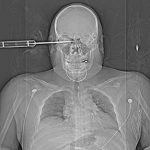Examination of the spine in trauma patients is typically not very helpful. We always look for stepoffs. swelling and tenderness, but the correlation with actual injury is poor. A recent paper presented at the American Medical Student Association Annual Convention showed that it actually can be helpful in victims of penetrating injury.
A prospective study of 282 patients was carried out at a Level I Trauma Center, specifically focusing on penetrating trauma. Half had gunshot wounds, and 8% sustained spinal injury with one third left with permanent disability. Stab wounds never led to a spinal cord injury. The most common patterns for cord injury in gunshot wounds was a single shot to the head or neck, or multiple shots to the torso.
The examiners looked for pain, tenderness, deformity and neurologic deficit. They found that the sensitivity was 67%, the specificity was 90%, the positive predictive value was 95% and the negative predictive value was 46%. These numbers are much better than those found during spine examination after blunt trauma. They also determined that prehospital immobilization after penetrating injury would not have helped, which I have also written about here.
Bottom line: A good spine exam in victims of penetrating trauma can accelerate definitive management prior to defining the exact details of the injury with radiographic or MRI imaging. This is particularly helpful in patients who present to non-trauma centers, where imaging or image interpretation may not be readily available.
Reference: American Medical Student Association (AMSA) 60th Annual Convention: Abstract 26: Presented March 11, 2010






